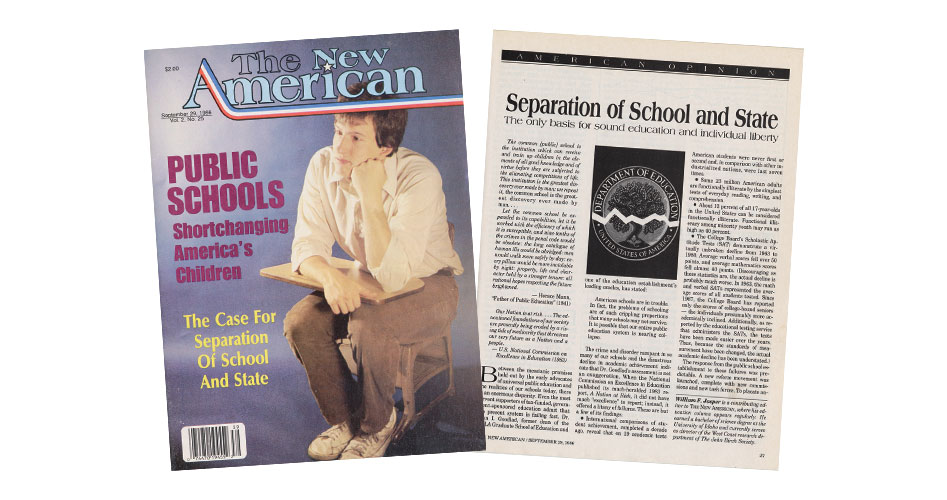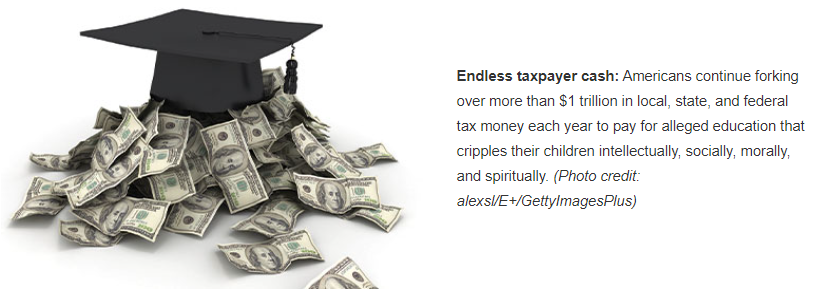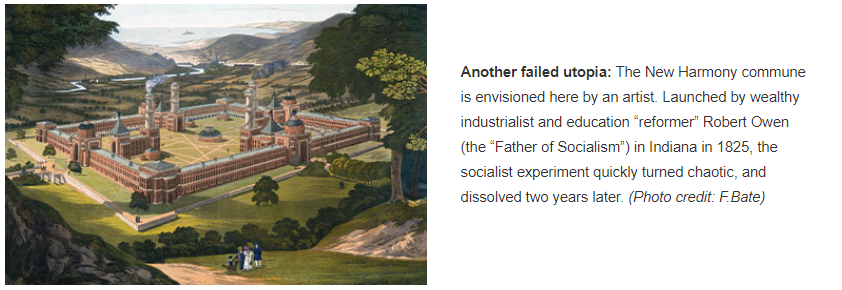
Separation of School and State
The government has no business directing any aspect of education. Public schools should be phased out in favor of private alternatives.
Since 1985, The New American has covered important issues that affect Americans and the American Republic. The magazine’s motto is “That Freedom Shall Not Perish.” In September of 1986, longtime contributor and senior editor of The New American William F. Jasper wrote the following deeply perceptive article about the success of American education prior to the creation of public schools, the corrupt motives of the architects and engineers who forged the public-school system, and the accelerating failures of government schools. Although 35 years have come and gone, we are reprinting an abridged version of this article to document both the prescience of Mr. Jasper and the forward-thinking nature of The New American regarding the long, fraught history of public education in America. Then, as now, not only does the federal government have no business directing or overseeing any aspect of the so-called public-school system, but that governmental system should be phased out in favor of private alternatives.
By William F. Jasper
“The American faith in education,” write professors David Tyack and Elizabeth Hansot, “did not originate with the common-school movement of the mid-nineteenth century, nor did widespread popular schooling begin with what we would now recognize as public education.”
In Managers of Virtue: Public School Leadership in America, 1820-1980, Tyack and Hansot describe education in our young Republic quite favorably:
One sign of the effectiveness of the many forms of education in the United States was that Americans were among the most literate people in the world. In the 1840 census, about 90 percent of white adults were listed as literate. A recent study of a sample of the 1860 census shows that 94 percent of free males were literate, and among these the older men were only slightly less literate than the younger ones, indicating that instruction had been widespread even early in the nineteenth century.
What was the pattern of education that produced such results? It was highly diverse. In the early nineteenth century citizens tended to have an attitude toward education that Americans today have toward religion: attend the school of your choice. The choices largely reflected differences of class, religion, ethnicity, race, sex, and regional tastes and needs…. Benevolent societies and churches, sometimes aided by governments, established charity schools for children whose families were too poor to afford schooling.
Earlier still, John Adams remarked in 1765, regarding our educational attainment: “[A] native of America who cannot read or write is as rare an appearance … as a comet or an earthquake.”
By all the available evidence, early Americans did quite well without government schools. In Massachusetts, government-sponsored “common schools” existed primarily as a legacy of the Puritan colonists’ concern for promoting Bible study, but they bore little resemblance to our current expansive system. At any rate, by the early 1800s most parents had abandoned them for the diverse, flourishing private schools.
When a small group of “reformers” in 1817 petitioned the Boston town meeting to extend the common schools to the primary level, a subcommittee was appointed, chaired by distinguished architect Charles Bulfinch, to survey the city’s educational needs. The Bulfinch report, says education historian Samuel Blumenfeld, revealed that “an astonishing 96 percent of the town’s children were attending school, and the 4 percent who did not, had charity schools to attend if their parents wanted them to. Thus there was no justification at all for the creation of a system of public primary schools, and Bulfinch reported as much to the School Committee, which accepted the sub-committee’s recommendation” (Is Public Education Necessary?).
Since “public education” was obviously not necessary, it is logical to ask how and why it came about. The answer to that has more to do with politics than education. By and large, the individuals most instrumental in establishing government control over schooling were socialists and secular humanists who were more imbued with the ideas of Robert Owen (the “Father of Socialism”) and German philosopher Georg Wilhelm Hegel (Karl Marx’s major mentor) than with the constitutional principles and Biblical morality that held sway during our founding period.
Origins of Public Education
When Robert Owen came to the United States in 1825 to set up his utopian commune at New Harmony, he found a significant following among the American intelligentsia. One of those was the influential writer and editor Orestes Brownson, who later converted to Christianity and exposed the devious and conspiratorial methods by which the Owenites had fastened statist schooling upon America. For the Owenites, wrote Brownson:
“The great object was to get rid of Christianity, and to convert our churches into halls of science. The plan was not to make open attacks on religion although we might belabor the clergy and bring them into contempt where we could; but to establish a system of state, — we said national — schools, from which all religion was to be excluded, in which nothing was to be taught but such knowledge as is verifiable by the senses and to which all parents were to be compelled by law to send their children.
Horace Mann, writing to his friend Henry Barnard, spoke of state education as a “beautiful and glorious development,” and “the greatest of earthly causes. It is part of my religion to believe that it must prevail.” Mann opined that the common schools would “create a more far-seeing intelligence and a purer morality than has ever existed among communities of men.”
Dewey’s Dismal System
This same messianic view of the school carried into the 20th Century. John Dewey, commonly referred to as the “father of progressive education,” and the most celebrated of American educators, was a humanist-atheist; yet he spoke of education in reverential tones. “The teacher,” he declared, “is engaged not simply in the training of individuals, but in the formation of the proper social life”; and “in this way the teacher always is the prophet of the true God and the usherer in of the true kingdom of God.”
The public school movement was motivated by the notion that the State — and not God — is the “savior” of mankind. According to historian Lawrence Cremin, these zealous missionaries for a new social order believed that, “once public schools were established, no evil could resist their salutary influence. Universal education could be the ‘great equalizer’ of human conditions, the ‘balance wheel of the social machinery,’ and the ‘creator of wealth undreamed of.’” Historian Henry Steele Commager, a firm supporter of public education, wrote: “To our schools went the momentous responsibility of inspiring a people to pledge and hold allegiance to the principles of democracy, nationalism, Americanism, egalitarianism.”
The Case for Private Schools
Basic principles have not changed since America’s founding era, and any objective comparison between private and public education today would weigh heavily in favor of private education. The most extensive such comparison to date is the much-discussed “Coleman Report” (High School Achievement: Public, Catholic and Private Schools Compared by James S. Coleman, Thomas Hoffer and Sally Kilgore) that came out of the 1980 survey of 1,015 high schools by the National Opinion Research Center at the University of Chicago. Among its conclusions:
“There are at least two important ways in which private schools produce higher achievement outcomes than public schools. First, given the same type of student (that is, with background standardized), private schools create higher rates of engagement in academic activities. School attendance is better, students do more homework, and students generally take more rigorous subjects (for instance, more advanced mathematics). The indication is that more extensive academic demands are made in the private schools, leading to more advanced courses and thus to greater achievement. This is a somewhat obvious conclusion, and the statistical evidence supports it. Second, student behavior in a school has strong and consistent effects on student achievement. Apart from mathematics coursework for seniors, the greatest differences in achievement between private and public schools are accounted for by school-level behavior variables (that is, the incidence of fights, students threatening teachers, and so forth). The disciplinary climate of a school, such as the effectiveness and fairness of discipline and teacher interest, affect achievement at least in part through their effect on these school-level behavior variables.
The Coleman study, which was based on a broad representative sampling of schools made up of students from diverse ethnic, religious and income backgrounds, indicates that private schools probably are also better at achieving some of the stated “social” goals of the public schools — for example, integration among different racial and income groups. The researchers found that overall “blacks and whites are less segregated within Catholic schools than are blacks and whites in public schools.” The study reported that “the other private sector (non-Catholic) is least racially segregated and the public sector by far the most segregated.” The survey also found “the public sector showing slightly higher income segregation than either the Catholic or other private sectors.”

Further, the private sector was far more successful in closing the academic achievement gap between students from “advantaged” and “disadvantaged” backgrounds. According to the study: “Altogether, the evidence is strong that the Catholic schools function much closer to the American ideal of the ‘common school,’ educating children from different backgrounds alike, than do the public schools.” Finally, the authors write, “The greatest difference found in any aspect of school functioning between public and private schools was the degree of discipline and order in the schools.”
Honest Competition
The 19th Century English philosopher Herbert Spencer wisely observed, “In education as in everything else, the principle of honourable competition is the only one that can give present satisfaction or hold out promise of future perfections.” A more contemporary scholar, professor Dwight R. Lee, explained another important political-economic aspect of government schooling:
“As long as education is provided publicly, it will be controlled by, and for the benefit of, public education professionals. The reason for this is straightforward.
As opposed to market decisions where each consumer exerts direct and decisive control over the services he chooses to purchase, no one individual has decisive control over the political decisions which determine the publicly provided services all consumers are required to “purchase.” Seeing no advantage in becoming informed and active in pursuit of objectives over which he has no direct control, the typical citizen-consumer quite rationally devotes little effort to influence public education policy. In contrast, suppliers of public education have significant political influence over public education policy by virtue of the fact that they are organized through professional associations, have a concentrated interest in decisions affecting public education, and are widely perceived as education experts….
As long as education is funded publicly, decisions on educational policy will be made politically, the interests of consumers will remain diffused and unorganized, and dominated by the focused and organized interests of the public school professionals [The Freeman, July 1986].
Mind Control
English philosopher John Stuart Mill, in his famous treatise On Liberty, written in 1859, saw the dangers all too clearly:
“A general state education is a mere contrivance for moulding people to be exactly like one another; and as the mould in which it casts them is that which pleases the predominant power in the government, whether this be a monarch, a priesthood or an aristocracy, or the majority of the existing generation, in proportion as it is efficient and successful, it establishes a despotism over the mind, leading by natural tendency to one over the body.
Mill’s warning seems particularly prescient when one reads the occasional candid confessions of collectivist educators who lust after young minds to mold. Dr. Fred Gates, in charge of the Rockefeller Foundation’s General Education Board in the early 1900s, wrote in the Board’s Occasional Paper No. 1: “In our dreams we have limitless resources and the people yield themselves with perfect docility to our moulding hands. The present educational conventions fade from our minds, and unhampered by tradition, we work our own good will upon a grateful and responsive rural folk.”
Another leading educator of the “progressive” era, sociologist Edward A. Ross, gave this vision of the state’s role in education: “To collect little plastic lumps of human dough from private households and shape them on the social kneading board….” Yes, we are mere lumpen proletariat, to be molded by omniscient commissars.

Similarly the National Education Association stated in the January 1969 issue of the NEA Journal: “Schools [are to become] ‘clinics’ whose purpose is to provide individualized psycho-social ‘treatment’ for the student, thus increasing his value both to himself and to society.”
Compulsory attendance laws, teacher certification requirements, accrediting regulations, health and safety codes, and a myriad of other restrictions are being used to intimidate parents, clergymen, and educators whose only “crime” is to seek a decent education for their children. Many of these fine, conscientious people are now suffering prosecution or are serving jail sentences with common criminals. This resort to coercion is a final admission of failure and a ringing indictment of the public “education” system.
Why Not Freedom?
What then is the answer to these problems? Twenty years ago, constitutional scholar and commentator Dan Smoot spelled it out. In the Dan Smoot Report for October 10, 1966 he wrote:
“By substituting private financing for federal aid and school taxes, we would eliminate government compulsion which is not only unjust and (as concerns the federal government) unconstitutional, but is also the source of our major educational problems.
Then, people with no children in school would not be forced to pay for educating other people’s children. Parents with school-age children could patronize the kinds of schools they want. Those who want church schools could support church schools. Those who want non-sectarian private schools, or trade schools, or special-purpose schools, or schools of classic instruction, or segregated schools, or integrated schools — could do likewise….
How about children whose parents could not pay tuition? The people of America voluntarily contribute enough money to maintain churches for millions of members; and they voluntarily support religious, educational, charitable, artistic, and scientific institutions all over the world. It is absurd to say they would not educate children of the poor without the force of law.
If the billions now confiscated in taxes for our extravagantly expensive government schools were left in the hands of the people, there would be enough money in every community to build and operate all necessary educational institutions. [Public education expenditures for the 1985-86 school year were estimated at $214.2 billion by the U.S. Government’s National Center for Education Statistics.]”
And how will this come about? Smoot continued:
“We will solve our major education problems when the people elect governors, state legislators, U.S. Congressmen, and a President who have the courage and good sense to say:
How dare a government, professing to be free, lay violent hands on children and force them to attend particular schools, study particular books, under particular teachers?
Whence does government derive the right to take advantage of my children and say when, where, what, and by whom they shall be taught? Whence does government derive the right to seize another man’s money for the education of my children?”
How dare a government, professing to be free, invade the domain of private duty and private right that God assigned to parents?
***
Afterword (2021): From every possible angle, and across all pedagogical and economic comparisons, the arguments (and the well-documented history of the American public-school system) demonstrate clearly that the federal government is incapable of overseeing and directing public schools, which should be phased out in favor of private education. The red tape, funding contradictions, political divides, and sheer stagnation and gridlock of our system of government guarantee that the more the federal government is in control, the less serious education will occur, and the more issues of politics and control will warp the system. Beyond the issue of capacity, the federal government is not permitted by the U.S. Constitution to play any role in public education. In spite of such successful assaults on the constitutional order as the creation of a federal Department of Education, the feds still have an extremely weak argument for the control that they have already usurped, and absolutely no mandate at all for the kind of control for which they are ultimately aiming.
After reading the intentions of the educrats mentioned in this article (and hosts of others unnamed here), it is abundantly clear that the creation of a public-school system was a matter of control, not education, one in which compulsory government schools ripped children from families, divorced them from their faith and their local communities, and remolded them in the image of materialists, atheists, and socialists.
Published with Permission of thenewamerican.com
